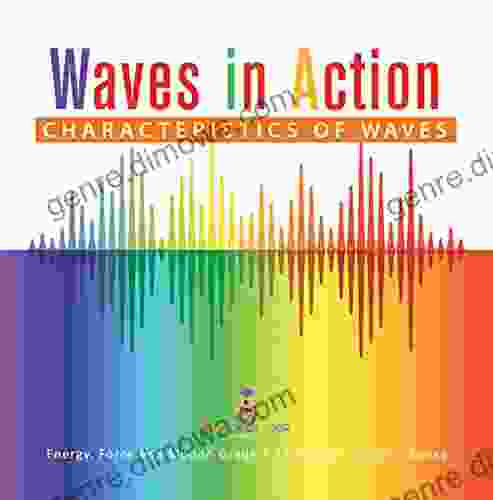Characteristics of Waves: Energy, Force, and Motion for Grade Children Physics

Waves are a fascinating part of our world. They can be found everywhere, from the ripples in a pond to the sound waves that allow us to hear. But what exactly are waves? And how do they work?
In this article, we will explore the characteristics of waves, including their energy, force, and motion. We will also provide some real-world examples of waves and how they are used in everyday life.
What is a Wave?
A wave is a disturbance that travels through a medium. The medium can be anything, from water to air to even a solid object. When a wave passes through a medium, it causes the particles in the medium to vibrate. This vibration can be seen as a ripple or a wave.
4.3 out of 5
| Language | : | English |
| File size | : | 25718 KB |
| Screen Reader | : | Supported |
| Print length | : | 72 pages |
The most common type of wave is a mechanical wave. Mechanical waves require a medium to travel through. Sound waves, for example, are mechanical waves that travel through the air. Water waves are mechanical waves that travel through water.
There are also non-mechanical waves, such as electromagnetic waves. Electromagnetic waves do not require a medium to travel through. They can travel through a vacuum, such as the space between the Earth and the sun. Light waves and radio waves are examples of electromagnetic waves.
Characteristics of Waves
Waves have a number of different characteristics, including:
- Amplitude: The amplitude of a wave is the height of the wave from the trough to the crest.
- Wavelength: The wavelength of a wave is the distance from one crest to the next.
- Frequency: The frequency of a wave is the number of crests that pass by a given point in one second.
- Speed: The speed of a wave is the distance that the wave travels in one second.
The energy of a wave is determined by its amplitude and frequency. The greater the amplitude and frequency, the more energy the wave has.
The force of a wave is determined by its energy and wavelength. The greater the energy and wavelength, the greater the force of the wave.
The motion of a wave is determined by its speed and frequency. The greater the speed and frequency, the faster the wave will move.
Real-World Examples of Waves
Waves are found everywhere in the world around us. Here are a few examples of waves:
- Water waves: Water waves are created when the wind blows across the surface of a body of water. Water waves can be small ripples or large waves that can cause damage to property and infrastructure.
- Sound waves: Sound waves are created when an object vibrates. Sound waves can travel through the air, water, and solid objects. We can hear sound waves because they cause our eardrums to vibrate.
- Light waves: Light waves are created when an object emits light. Light waves can travel through the vacuum of space and can be used to see objects.
- Radio waves: Radio waves are created when an object emits electromagnetic radiation. Radio waves can travel through the vacuum of space and can be used to communicate over long distances.
How Waves are Used in Everyday Life
Waves are used in a variety of everyday applications, including:
- Transportation: Boats and ships use waves to travel across water. Airplanes use waves to travel through the air.
- Communication: Radio waves are used to transmit information over long distances. Microwaves are used to heat food and cook meals.
- Medical imaging: Ultrasound waves are used to create images of the inside of the body. X-rays are used to create images of bones and teeth.
- Entertainment: Sound waves are used to create music and other forms of entertainment. Light waves are used to create images in movies and television shows.
Waves are a fascinating and important part of our world. They are used in a variety of everyday applications and can be found everywhere around us. By understanding the characteristics of waves, we can better appreciate their importance and use them to our advantage.
4.3 out of 5
| Language | : | English |
| File size | : | 25718 KB |
| Screen Reader | : | Supported |
| Print length | : | 72 pages |
Do you want to contribute by writing guest posts on this blog?
Please contact us and send us a resume of previous articles that you have written.
 Book
Book Novel
Novel Page
Page Chapter
Chapter Text
Text Story
Story Genre
Genre Reader
Reader Library
Library Paperback
Paperback E-book
E-book Magazine
Magazine Newspaper
Newspaper Paragraph
Paragraph Sentence
Sentence Bookmark
Bookmark Shelf
Shelf Glossary
Glossary Bibliography
Bibliography Foreword
Foreword Preface
Preface Synopsis
Synopsis Annotation
Annotation Footnote
Footnote Manuscript
Manuscript Scroll
Scroll Codex
Codex Tome
Tome Bestseller
Bestseller Classics
Classics Library card
Library card Narrative
Narrative Biography
Biography Autobiography
Autobiography Memoir
Memoir Reference
Reference Encyclopedia
Encyclopedia Nicholas Fox Weber
Nicholas Fox Weber Mario F Triola
Mario F Triola Natalie M Scala
Natalie M Scala Rita Korsunsky
Rita Korsunsky Mathew J Bartkowiak
Mathew J Bartkowiak Lazyprogrammer
Lazyprogrammer Lucy Worsley
Lucy Worsley Kostya Kennedy
Kostya Kennedy Sarah Farrell
Sarah Farrell Lavina Solomonova
Lavina Solomonova Lucy Tempest
Lucy Tempest Yuliia Pozniak
Yuliia Pozniak Srividhya Venkat
Srividhya Venkat Walt Whitman
Walt Whitman Mohsen Razavy
Mohsen Razavy Lou Pedron
Lou Pedron Steve Markwith
Steve Markwith Pamela Walker
Pamela Walker Pam Russ
Pam Russ Kiran Chandra
Kiran Chandra
Light bulbAdvertise smarter! Our strategic ad space ensures maximum exposure. Reserve your spot today!

 Bryson HayesSecondary School KS4 Key Stage GCSE Maths Number Patterns And Sequences Ages...
Bryson HayesSecondary School KS4 Key Stage GCSE Maths Number Patterns And Sequences Ages... Forrest BlairFollow ·7.7k
Forrest BlairFollow ·7.7k Dillon HayesFollow ·2.1k
Dillon HayesFollow ·2.1k Jermaine PowellFollow ·17.2k
Jermaine PowellFollow ·17.2k Bryce FosterFollow ·6.4k
Bryce FosterFollow ·6.4k Jan MitchellFollow ·15.3k
Jan MitchellFollow ·15.3k Ted SimmonsFollow ·19k
Ted SimmonsFollow ·19k Cameron ReedFollow ·15.2k
Cameron ReedFollow ·15.2k Alan TurnerFollow ·10.8k
Alan TurnerFollow ·10.8k

 Langston Hughes
Langston HughesUnlock Your Teaching Dreams with Nystce Mathematics 004...
Elevate Your Preparation...

 Finn Cox
Finn CoxUnlock Your Mtel Music 16 Certification: A Comprehensive...
: Embark on the Path...

 Calvin Fisher
Calvin FisherThe Unforgettable Journey of Self-Discovery in "Out of...
An Extraordinary Journey of Growth and...

 Isaiah Price
Isaiah PriceWhy Am I So Happy Dating With a Bolivian Girl?
I've been dating my...

 Junichiro Tanizaki
Junichiro TanizakiVolume: The Hole Inside the Earth - Discover the...
Delve into the...
4.3 out of 5
| Language | : | English |
| File size | : | 25718 KB |
| Screen Reader | : | Supported |
| Print length | : | 72 pages |












